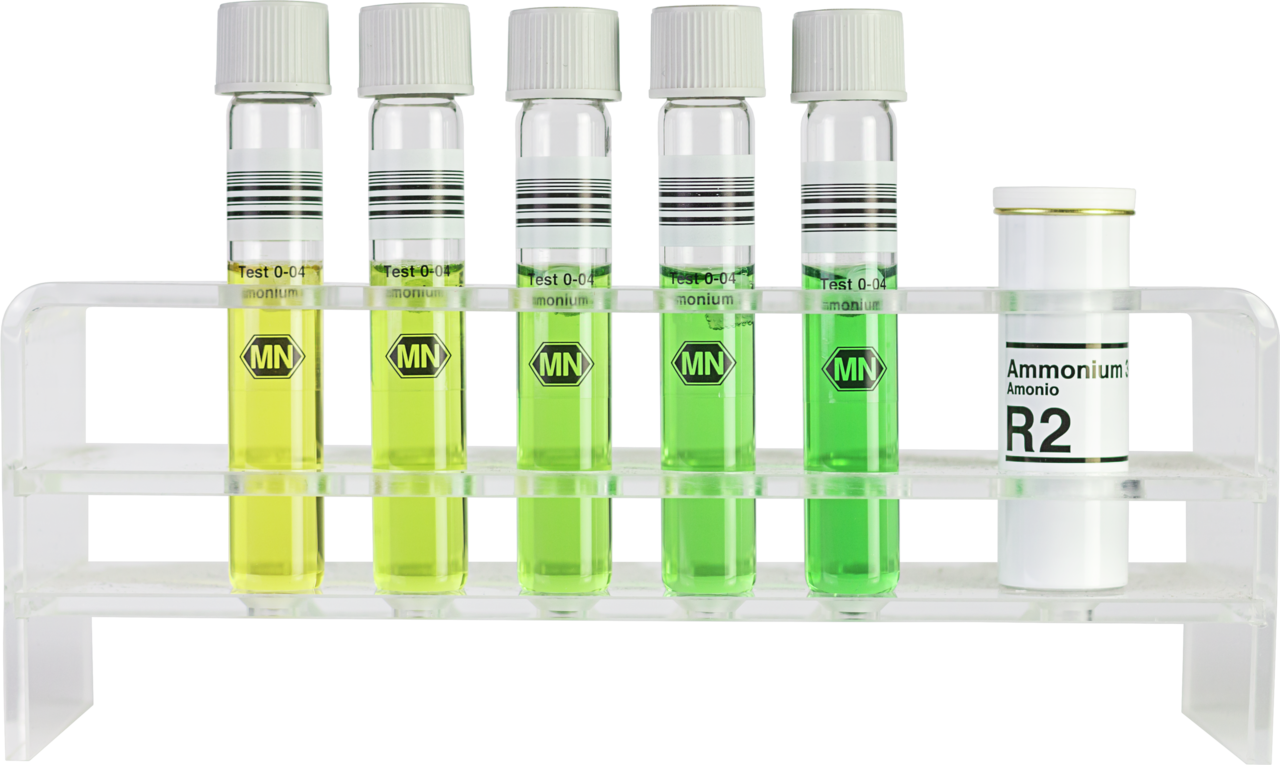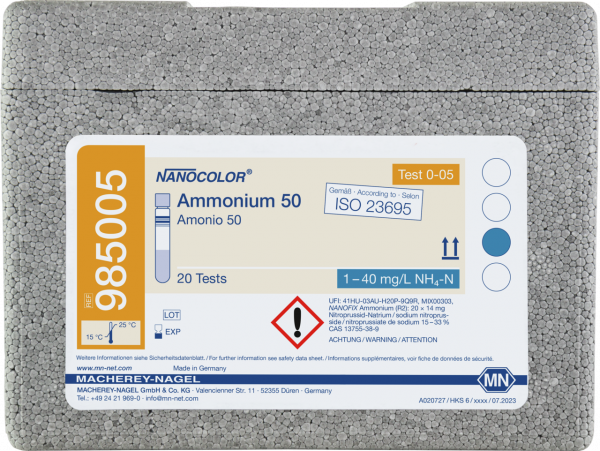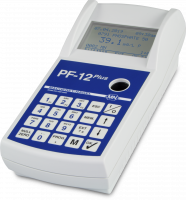Tube test NANOCOLOR Ammonium 50
*taxes and shipping not included
Delivery time approx. 5 working days
Tube test for the determination of Ammonium. Precise rapid tests for all kind of water and waste water samples. Time-saving and reliable analysis together with our NANOCOLOR photometers.
| Brand | NANOCOLOR |
| Platform | NANOCOLOR tube tests |
| Parameter | Ammonium |
| Measuring range | Ammonium - 1–40 mg/L NH₄-N, Ammonium - 1–50 mg/L NH₄⁺ |
| Sludge reagent set | No |
| Test No. | 0-05 |
| Evaluable on | 500 D, Advance, MT Easy UV, MT Easy VIS, PF-3 Soil, PF-12Plus, UV/VIS II, VIS II |
| Based on norm | In accordance with ISO 23695 2023-02 – Analogous to APHA 4500-NH3 F, ISO 7150-1, DIN 38406 – E5, EPA 350.1 |
| Method | Ammonium - Indophenol |
| NanOx N | No |
| NanOx Metal | No |
| Crack-Set | No |
| Sea water analysis | Yes |
| Application | drinking water, groundwater, slightly contaminated wastewater, surface water |
| Test range | Low |
| Test method | Photometric |
| Remark | Measuring range on NANOCOLOR VIS II |
| Shelf life (from production) | 1 Year(s) |
| Storage temperature | 15–25 °C / 59–77 °F |
| Scope of delivery | Rugged box with 20 test tubes. Sufficient for 20 tests. |
| Gross weight (incl. packaging) | 452 g / 1 lbs |
| Packaging dimensions | 155 x 105 x 115 mm / 6.10 x 4.13 x 4.53 Inch |
| Hazardous material | Yes |
- Download Instruction / Anleitung / Manuel
- Download Pictogram / Piktogramm / Pictogramme
- Download Validation data / Validierungsdaten / Données de validation
- Download Flyer NANOCOLOR analysis system (EN)
- Download Flyer Das NANOCOLOR Analysensystem (DE)
- Download Flyer Système d’analyse NANOCOLOR (FR)
- Download NANOCOLOR analysesysteem (NL)
Ammonium
Reaction basis
Colorimetric and photometric determinations are performed in accordance to the Berthelot reaction (underlying reaction in analogy to ISO 7150-1, APHA 4500-NH3-F, EPA 350.1 and DIN 38406-E5).
Ammonium or ammonia reacts with hypochlorite and salicylate in strongly alkaline solution (pH ≈ 12.6), in the presence of sodium nitroprusside (sodium (nitrosopentacyanoferrate(III)) as a catalyst to form a blue indophenol. In the first reaction step, hypochlorite is generated in situ from dichloroisocyanuric acid in alkaline medium.
| R-Cl + NaOH → NaOCl + R-H |
The hypochlorite reacts with ammonia to form chloramine.
| NH3 + NaOCl → NH2Cl + NaOH |
With a catalytic amount of sodium nitroprusside, chloramines react with phenols (here: sodium salicylate) to form quinonimines. The quinonimine reacts with a further equivalent of sodium salicylate, resulting in a blue indophenol.
Fig. 2: Reaction principle of the formation of the blue indophenol.
Sample preservation
The sample can be stored for 7 days until the start of analysis, after stabilization of the pH with H2SO4 to pH 1–2 and filtration on site (storage vessel: PE or glass bottle).
Tips & tricks
Sea water suitability
Almost all VISOCOLOR and NANOCOLOR ammonium tests are suitable for sea water analysis; some require dilution (1+1 or 1+9). For more information, please refer to the respective instruction leaflet.
pH
The reaction solution or sample must not be too acidic. Strongly acidic and buffered samples must be adjusted to a pH in the required range before the test, using sodium hydroxide. Different pH values of the sample solution are required depending on test kit and measurement range. The exact specification can be found in the instruction leaflets.
The ammonium nitrogen in water is present in the equilibrium NH4+ / NH3 (NH4OH) depending on the pH; both forms are completely detected by the analysis.
The pH values for the sample solutions stated in the instruction leaflets must be complied with.
Reaction temperature
The reaction temperature must be controlled, because the reaction time of 15 min applies only at T = 20 °C. Different temperatures may yield lower apparent results.
Background information
The NANOCOLOR Ammonium tube tests meet the requirements of ISO 23695:2023-02: Water quality — Determination of ammonium nitrogen in water — Small-scale sealed tube method.
This standard method specifies the determination of ammonium in drinking water, groundwater, surface water, wastewater, bathing water and mineral water with measuring ranges from 0.01–1800 mg/L NH4-N.
These standards provide clear guidelines and procedures for accurately measuring of ammonium in water samples. By adhering to these standards, our customers can be sure that our NANOCOLOR test kits are precise, reliable and comparable.
Interferences
Primary amines react like ammonium ions and therefore lead to higher apparent results.
Chlorine-consuming substances can lower the result or even inhibit the reaction, depending on concentration.
Further interfering ions are listed in the instruction leaflets.
Color formation is suppressed in case of highly concentrated samples (multiple concentration) of oxidizable substances, e.g. a high COD. In this case, the problem can be solved by dilution.

Fig. 1: Concentration series of our NANOCOLOR Ammonium tube test with increasing Ammonium concentration.
How to perform the NANOCOLOR Ammonium tube test
General information
There are various reasons for the presence of ammonium compounds in different types of water. They are e.g. products of chemical waste or they are bacterial degradation processes of nitrogen-containing organic compounds. The latter indicate pollution of the water with feces or other putrefaction and decay processes.
Ammonium compounds enter our waters also with the rain, in the form of fertilizer ingredients being washed into the water. Almost all volcanic rocks In the mineral kingdom contain small quantities of ammonium salts. The ammonium content in pure waters is less than 0.1 mg/L; special cases with levels up to 1 mg/L are swamp waters and special groundwaters with high iron and manganese contents (e.g. in the North German Plain). In polluted waters, concentrations up to 10 mg/L can be detected.
Toxicity in fish waters is mainly dependent on the pH of the water. Ammonium compounds are harmless at low pH values. However, with increasing pH an increasingly higher portion of fish-toxic ammonia is present. This can be explained from the following pH-dependent equilibrium between ammonium ions and ammonia:
| NH4+ + OH- ⇌ NH3 + H2O |
| pH < 7 (acidic) pH > 7 (alkaline) |
At a pH of 6, the equilibrium is almost entirely on the left side, at a pH value of 8 already 4 % of ammonia, at pH 9 already 25 % and at pH 10 even 78 % of ammonia are present (at a water temperature of 17 °C). The level of toxicity depends on exposure time, temperature and fish species. On average, 1 mg/L NH3 is reported as lethal to fish. High ammonium concentrations also strongly decrease the oxygen concentration in water, since the bacterial oxidation of ammonium to nitrate (“nitrification”) consumes oxygen O2:
| NH4+ + 2 O2 + H2O → NO3- + 2 H3O+ |
Nitrification is essential for the natural purification process in water. But in case of high ammonium or ammonia content the nitrification leads to increased oxygen consumption and thus kills fish.
The nitrification process is utilized in biological wastewater treatment plants for cleaning. Therefore, monitoring of the involved parameters ammonium, nitrite and nitrate plays an immense role. The ammonium concentration in the influent determines the oxygen demand in wastewater treatment plants. Thus the residual ammonium content in the plant effluent provides information on th effectiveness of the system.
Ammonia is cytotoxic to higher organisms. It is produced as a metabolic intermediate in the brain, the muscles, the liver, the intestine and the kidney. In the body, ammonia is immediately rendered harmless by the reaction with carbon dioxide to urea and the following conversion to glutamine. Unlike free ammonia, ammonium salts are non-toxic.
Ammonium compounds are present in many surface waters and some groundwaters. Furthermore, they are always present in municipal and often in commercial and industrial wastewaters.
Toxicity in fish waters is mainly dependent on the pH value of the water.
NH4+ = ammonium ion
OH– = hydroxide ion
NH3 = ammonia
H2O = water
O2 = oxygen
NO3– = nitrate ion
H3O+ = hydronium ion
Ammonium salts are non-toxic, unlike free ammonia.
R-Cl = dichloroisocyanuric acid
R = generic residue
NaOH = sodium hydroxide
NaOCl = sodium hypochlorite
NH3 = ammonia
NH2Cl = chloramine
















